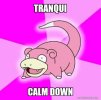There's been some arguing, yes, but there's also been some discussion.This is a lot of arguing on a post about such a cute illustration art.
Yes, the two examples you named are ones that many people struggle with even after they have been playing the game casually for many years. I wouldn't say Yaginku is insulting the intelligence of kids, though. One point worth considering is how many rules many kids actually learn when they start playing the game casually. I saw the rules booklet that came with my friend's Chien-Pao ex deck, and it was surprisingly bare-bones (even the "advanced steps" felt like extremely fundamental game rules). The playmats that came with the XY era theme decks I remembered learning to play with were more detailed, but they couldn't hold a candle up to the Legends Awakened theme deck rules book that I got along with someone's collection. That rulebook was packed with rules I never learned from the playmats, possessed many cross-generational interactions (the only features of any older era featured on the XY playmats were free attacks, which required them to use Magby from Call of Legends as an example), and it even had a small compendium at the back (It also had an advert for the Play! Pokémon program of the time, which mentioned events like Battle Roads and Nationals which no longer exist).It seems like the one struggling with the term Rule box is you not gonna lie. Do not insult the kids intelligence it really isnt the hardest concept to grasp. Cards that have "stop effects of attacks" or "ignore any effects on your opponent's Active Pokémon" seem to be harder for players to understand for any age from what Ive personally have seen. Idk its just hard to understand that Zoroark and Lana for example, these are very deliberate choices, I just dont feel theres a randomness to it, they choose what they think is best, again, wether you agree or not it was the best and regardless of their motive at large
I doubt the children of today are less intelligent than those of the XY era (at least I can't think of evidence to that conclusion), but for whatever reason, Pokémon is providing fewer and fewer rules in the instruction booklets to their entry-level decks, meaning that children who want to thoroughly understand the game will have to resort more and more to searching for additional sources. I'm not sure how many will.
How does this apply to the discussion about the intelligence of children? It shows that Pokémon has seen a need for simplifying the TCG experience, regardless of whether the average child has actually become less intelligent since 2014 or 2007.
Let's say a new player who has only read the rulebook from an ex Battle Deck reads the effect of Lana, which mentions "Pokémon with a Rulebox." This statement is followed by the clarification "(Pokémon ex, Pokémon V, etc., have a Rule Box). This player has a deck containing an ex, a V, and a Radiant Pokémon


